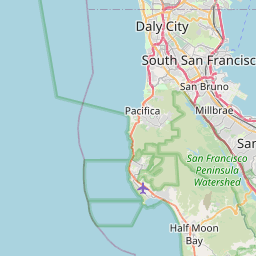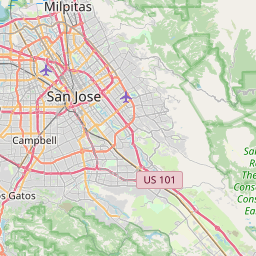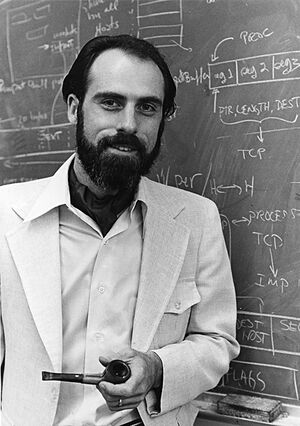Milestones:Transmission Control Protocol (TCP) Enables the Internet, 1974
- Date Dedicated
- 2024/05/20
- Dedication #
- 254
- Location
- Stanford, CA
- IEEE Regions
- 6
- IEEE sections
- Santa Clara Valley
- Achievement date range
- 1974
Title
Transmission Control Protocol (TCP) Enables the Internet, 1974
Citation
In May 1974, the IEEE Transactions on Communications scientific journal published “A Protocol for Packet Network Intercommunication.” Authored by Vinton Cerf and Robert Kahn, this paper described the Transmission Control Protocol (TCP) that supported the interconnection of multiple packet-switched networks into a network of networks. Split later into TCP and an Internet Protocol (IP), TCP and IP became core components of the Internet that DARPA launched operationally in 1983.
Street address(es) and GPS coordinates of the Milestone Plaque Sites
- Site 1: Gates Computer Science Building, 353 Jane Stanford Way, Stanford, CA 94305-5008 US (37.4300184, -122.1733027) (not yet installed)
- Site 2: Computer History Museum, 1401 N. Shoreline Blvd, Mountain View, CA 94043 US (37.414757, -122.077679)
Details of the physical location of the plaque
- Site 1: On the 4th Floor in an Internet-focused section of a new Exhibit Area that showcases the rich history of Stanford's Computer Science Dept.
- Site 2: On the inside face of the front patio brick wall, near the museum's Main Entrance
How the plaque site is protected/secured
- Site 1: Building security; open to the public on weekdays from 8am-6pm
- Site 2: Building security; 24/7 access
Historical significance of the work
The Internet is a global, collaborative communication system supporting today's World Wide Web along with its applications, smartphones, cloud computing services, social networking services, video streaming, and countless Internet-enabled appliances. This has led to the creation of some of the world's largest companies by revenue and market capitalization measures. While Robert Kahn and Vinton Cerf are credited with the initial design of the Transmission Control Protocol (TCP), thousands if not millions of others have contributed to the hundreds of protocols, thousands of networks, millions of applications, and billions of devices that make up the global Internet.
In its earliest days, the non-proprietary transport layer protocol used by the ARPANET was Network Control Protocol (NCP). Discussions about packet-switched networks started in the 1960s, but Robert Kahn initiated an extension of this concept to include the “inter-networking” of distinct networks: “The idea of open-architecture networking was first introduced by Kahn shortly after having arrived at DARPA in 1972.” Ref5: Brief History of the Internet (Internet Society)
After Robert Kahn had conceived the “Internetting” project at DARPA, he asked Vint Cerf (who taught at Stanford University from 1972-76) to work with him on its detailed design. Starting in the Spring of 1973, they both collaborated on this effort. “Cerf had been intimately involved [at UCLA] in the original NCP design and development, [led by Stephen Crocker,] and already had the knowledge about interfacing to existing operating systems. So armed with Kahn’s architectural approach to the communications side and with Cerf’s NCP experience, they teamed up to spell out the details of what became TCP/IP.” Ref5: Brief History of the Internet (Internet Society) This led to Cerf and Kahn co-authoring a paper describing TCP titled “A Protocol for Packet Network Intercommunication” (Ref1: Cerf-Kahn IEEE 1974 Paper) which was submitted in late 1973 and published in the IEEE Transactions on Communications scientific journal in May 1974. This paper described the Transmission Control Protocol (TCP) that supported the interconnection of multiple packet-switched networks to form an internet.
Thus, Cerf’s and Kahn’s work together culminated in the initial design and specification of the then-core protocol of the Internet, TCP. In work done especially at Stanford in 1974, the first detailed TCP specification was published in December 1974 as RFC 675, with Vinton Cerf as its lead author. Ref2: RFC 675 (first detailed TCP Spec) By 1975, Kahn had funded work at Stanford; Bolt, Beranek and Newman (BBN); and University College London on the implementation of the RFC 675 TCP specification. In 1976, Cerf left Stanford to join DARPA in Arlington, VA, where he was the program manager for the Internetting project until joining MCI to build MCI Mail in late 1982.
TCP is split into TCP and IP
During the implementation and testing of TCP, Jon Postel, Danny Cohen (both at USC's Information Sciences Institute - ISI), and David Reed (at MIT) presented persuasive arguments in 1978 for the provision of a low-latency but not-necessarily complete transmission option in order to support real-time applications such as speech, radar tracking, and video where it was more important to deliver packets quickly, and to not necessarily assure 100% delivery. This was unlike email, file transfers, and remote terminal access wherein every bit counted. Implementation of both schemes required splitting the portion of the original TCP layer that included global network addressing and reliable delivery into a separate portion which was called the Internet Protocol (IP) layer. The remaining portion of TCP that enabled reliable stream delivery kept the TCP layer name. To provide the new option for fast but potentially unreliable delivery, a User Datagram Protocol (UDP) layer was created which ran in parallel with the TCP layer. Both TCP and UDP layer rode atop the IP layer.
The TCP/IP Protocol Suite
In 1983, TCP and IP together became the protocol suite, commonly known as TCP/IP, for use with the ARPANET, ARPA Packet Radio Network, and the ARPA Packet Satellite Network, thus forming the Internet. Specifically, on January 1, 1983, DARPA required that TCP/IP replace Network Control Protocol (NCP) as the transport layer protocol of all connected machines on the ARPANET. As such, TCP/IP and UDP/IP became the core protocols of the future global Internet. Ref4: History of Information Webpage Until a sufficient number of sites had implemented TCP/IP, however, NCP and TCP/IP were allowed to coexist for many months in 1983.
The Overall Impact of the Internetting Project
Although Vint Cerf inherited responsibility for DARPA's Internetting project, he emphasizes that its strength came from the enormously constructive and collaborative atmosphere in which the effort unfolded. Ideas were debated and evaluated by a growing team of very dedicated engineers who all genuinely wanted this network to work.
The 2023 Internet links about 5.3 billion people and many billions more devices, many of which enable access to millions of applications of the World Wide Web (WWW) that rides atop the Internet.
Justification for inclusion of the names of Vinton Cerf and Robert Kahn in the Citation
As described in the above paragraphs, both Cerf and Kahn were the two key people involved in crafting TCP and IP, and thus turning the ARPANET into the Internet’s “network of networks.” As noted in Ref3: Vinton Cerf IEEE Medal of Honor Recognition, Dr. Cerf is "the co-designer with Robert E. Kahn of the TCP/IP protocols and the architecture of the Internet.” While Ref3 cites many of Cerf's accolades and recognitions prior to his receipt of the IEEE Medal of Honor in 2023, he shares each of these and many more with Kahn (who will be receiving the IEEE Medal of Honor in 2024), including the US National Medal of Technology "for their joint development of the TCP/IP protocol" (1997; from President Clinton), the US Presidential Medal of Freedom "for designing the language that led to the internet" (2005; from President George W. Bush), the IEEE Alexander Graham Bell Medal (1997), IEEE Fellow (Kahn: 1981; Cerf: 1988), the Queen Elizabeth Prize for Engineering (2013; from the UK), the Japan Prize (2008), the Charles Stark Draper Prize for Engineering (2001), the ACM Turing Award (2004), ACM Fellow (Cerf: 1994; Kahn: 2001), Computer History Museum Fellow (Cerf: 2000; Kahn: 2006), the Prince of Asturias Award (2002; from Spain), the Harold Pender Award (2010), and the Marconi Prize (Kahn: 1994; Cerf: 1998; from Italy). Dr. Kahn's background and his receipt of the 2024 IEEE Medal of Honor is discussed in Ref7: Robert Kahn IEEE Medal of Honor Recognition.
Justification Support for Including Both Names from Expert Reviewer #1: Dr. Steve Crocker helped develop the initial protocols for the ARPANET, and created the Request for Comments (RFC) series of notes through which protocol designs are documented and shared. He’s been active in the IETF, Internet Society, and Internet Corporation for Assigned Names and Numbers (ICANN). He said "Bob Kahn and Vint Cerf formed a close and continuing collaboration to create the TCP/IP protocol. Further, they continued to work together for many years to create the Internet, and develop and promulgate the use of TCP/IP. They shared the vision and commitment, and they worked together closely. It is not only fitting for the plaque to include both of them – it would be inappropriate if it did not."
Justification Support for Including Both Names from Expert Reviewer #2: Dr. David Clark joined the Internet project at DARPA in the mid-1970s, where he implemented the Internet protocols for the Multics system, the Xerox PARC ALTO, and the IBM PC. From 1981-89, he was Chief Protocol Architect and Chair of the Internet Activities Board (IAB), and was inducted as an Internet Hall of Fame Pioneer in 2013. He said "I fully support the proposed Milestone. The contribution it acknowledges is one of profound importance. Cerf did the work while he was at Stanford, so their right to claim some history here is totally justified. While only Cerf was at Stanford, the contribution of Cerf and Kahn cannot be disentangled, so I believe that the citation has to mention both of them equally."
Features that set this work apart from similar achievements
The various business models for the support of Internet networks were rather challenging, and non-profit, for-profit, and government-operated networks were all supported. However, the innovative idea was network interconnection without settlements, unlike the telephone system model.
In a practice called peering, networks carried traffic for each other. Flat rate pricing, often varying with the maximum permitted data rate, and regardless of destination, was another innovative and simplifying practice.
However, the most important element of success of this work was its widespread implementation on many diverse operating systems, and the incorporation of many transmission technologies supporting the IP layer of the TCP/IP protocol stack. While other proposals had similar features, what distinguished TCP/IP more than anything else was its rapid proliferation, its robustness, and its tolerance for and support of modifications over time to improve performance. Its layered architecture, common to many other competing protocol stacks, was instrumental in accommodating changes and additions within the layers without affecting the other layers.
Obstacles (technical, political, geographic) that needed to be overcome
TCP and its successor TCP/IP were contemporary with two other non-proprietary internetworking proposals: (1) X.25/X.75 from the International Telecommunication Union Telecommunication Standardization Sector (ITU-T), then the Consultative Committee for International Telegraphy and Telephony (CCITT), and (2) the Open Systems Interconnection (OSI) protocols from the Organization for International Standardization (ISO). X.25/X.75 became a highly successful networking technology during the period in which TCP/IP was under development. The OSI system directly competed with TCP/IP for international acceptance. The arrival of the World Wide Web and its Hypertext Transfer Protocol (HTTP), Hypertext Markup Language (HTML), and its use of TCP/IP, all contributed greatly to the ultimate success of TCP/IP as a network interconnection method of choice, and thus the adoption and spread of the Internet.
Synthesis of Competing Protocols (1975-1993) During the period from 1975-1993, mainframe vendors supported proprietary protocols for networking. For example, IBM had Systems Network Architecture (SNA), Digital Equipment Corporation had DECNET, and Xerox had Xerox Network Systems (XNS). The Consultative Committee on Telegraphy and Telephony (CCITT; now ITU-T) had standardized the non-proprietary X.25/X.75, which were initially offered in countries including Canada (DATAPAC), the US (Telenet), the UK (PSS - Packet Switching Service), and France (TRANSPAC).
Some European participants in the International Network Working Group (INWG), which became Working Group 6.1 of the International Federation of Information Processing (IFIP) Technical Committee 6 (Communications), concluded that their work needed the imprimatur of a recognized International Standards body - and they turned to the Organization for International Standardization (ISO). This effort began with the development of a Reference Model for Open System Interconnection (OSI).
By the mid-1980s, TCP/IP proliferated by riding on the broad popularity of local area networks (LANs) and the UNIX operating system. Initially this was primarily in academic settings, but TCP/IP's popularity quickly spread to commercial environments as well.
The debate and competition for standards for network interconnection continued from the mid-1970s to the early 1990s. TCP/IP became more widely implemented, and available commercially and through open source, despite efforts to promote OSI through, for example, the Corporation for Open Systems.
In 1983, the US National Bureau of Standards (NBS, now the National Institute of Standards and Technology, NIST) and the US Department of Defense (DoD) asked the US National Research Council to evaluate the relative attributes of OSI and TCP/IP. The resulting report concluded that the OSI Transport Protocol 4 and TCP/IP v4 were functionally comparable, and that it was acceptable for the US Government agencies to acquire TCP/IP-based products and services in the absence of OSI products. DoD and NBS, however, persisted in viewing OSI as the long-term preferred choice. A decade later, partly as a result of the demonstration of widespread TCP/IP implementation at Interop exhibitions (held annually starting in 1988), the industry voted with its feet and adopted TCP/IP as the preferred option. Ref6: History of Communications, Ch. 14.5
One of the key elements that ended up leading to the overall success of TCP/IP was the proliferation of the World Wide Web starting in the early 1990s. WWW applications used the Hypertext Transport Protocol (HTTP) running on top of TCP/IP, and this resulted in the Internet providing an instant, proliferated platform on which WWW applications could be mounted.
Significant references
Ref1: Cerf-Kahn IEEE 1974 Paper Media:Ref1_A_Protocol_for_Packet_Network_Intercommunication_Cerf-Kahn_1974.pdf
Ref2: RFC 675 (first detailed TCP Spec) Media:Ref2_RFC-675.txt.pdf
Ref3: Vinton Cerf IEEE Medal of Honor Recognition Media:Ref3-Cerf-MedalOfHonor.pdf
Ref4: History of Information Webpage Media:Ref4_HistoryOfInformation_Cerf-Kahn_TCP-Paper.pdf
Ref5: Brief History of the Internet (1997) Media:Ref5-Brief-History-of-the-Internet_Internet-Society_1997.pdf
Ref6: History of Communications, Ch. 14.5 Media:Ref6-HistoryOfCommunications-Ch-14.5.pdf
Ref 7: Robert Kahn IEEE Medal of Honor Recognition Media:Ref7-Kahn-MedalOfHonor.pdf
Supporting materials
IEEE Spectrum stories:
Dedication Ceremony
A Celebration of 50 Years of the Internet
- Blog with Photos from "50 Years of the Internet" Event
- Eileen Clegg's Internet Evolution Tapestry as discussed by her and Vint Cerf
Martin Wasserman Interviews re: the 50th Anniversary of the Internet
- Internet Pioneer Vint Cerf
- Internet Historian Marc Weber
- IEEE History Committee Vice Chair Brian Berg
Map

















